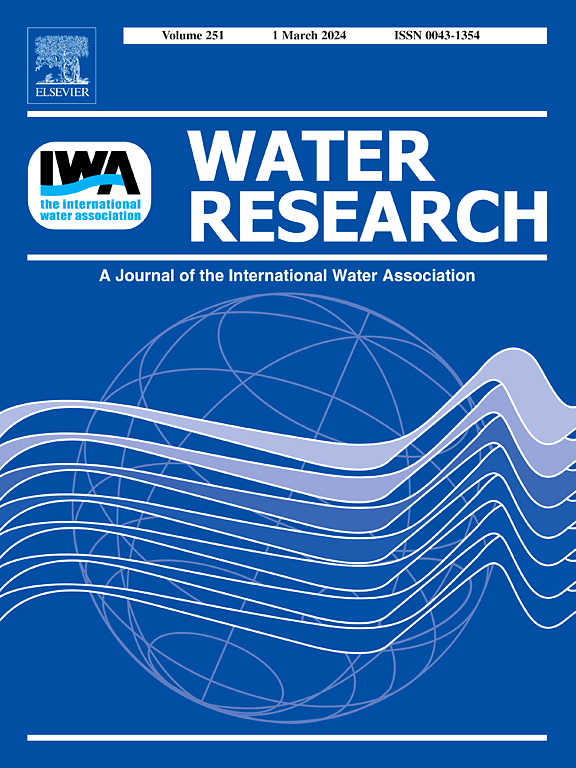Fast-selective electro-driven membrane reactor in fluoride/silica crystallization for microelectronic wastewaters recycling
IF 11.4
1区 环境科学与生态学
Q1 ENGINEERING, ENVIRONMENTAL
引用次数: 0
Abstract
Rapid growth of the microelectronic industry leads to a significant increase in the generation of microelectronic wastewaters containing complex pollutants. Resource recovery technologies offer promising solutions for effective wastewater reuse in the microelectronics sector. However, how to simultaneously achieve high-efficiency crystallization and high crystal purity of ionic resources from complex wastewater remains a challenge. Here, for the first time, we propose an electro-driven membrane reactor (EMR) for the ex-situ crystallization of fluoride/silica from microelectronic wastewaters as high-purity fluorosilicates. This EMR with independent chambers combines a bipolar membrane to produce protons for SiF62- generation from the reaction between fluoride and silica. An internal ultrafiltration membrane is used to reject nanoparticles/organics while providing ion channels for protons and SiF62- migration. Selective recovery of Na2SiF6 from the coexisting ions (Cl-, SO42-, NO3- and PO43-)/nanoparticles (SiO2, Al2O3 and CeO2)/organics (tetramethylammonium hydroxide, isopropyl alcohol, bovine serum albumin, sodium alginate and humic acid) is demonstrated. Over 99.5% Na2SiF6 purity and 64.5% crystallization rate are verified under the optimal conditions (voltage of 8 V, UH050 membrane, operation mode Ⅰ, and forward permeate flux of 1 mL min-1). This EMR with the advantages of accurate capture capability may be an innovative strategy for enlarging the scale of pollutant elimination, ionic resources and fresh water recovery from micro-electronic wastewaters.

用于微电子废水循环利用的氟/硅结晶快速选择电驱动膜反应器
微电子工业的快速发展导致含有复杂污染物的微电子废水的产生显著增加。资源回收技术为微电子行业废水的有效再利用提供了有前途的解决方案。然而,如何从复杂废水中同时实现离子资源的高效结晶和高结晶纯度仍然是一个挑战。在这里,我们首次提出了一种电驱动膜反应器(EMR),用于从微电子废水中提取氟/二氧化硅作为高纯度氟硅酸盐的非原位结晶。这种具有独立腔室的EMR结合了双极膜,从氟和二氧化硅之间的反应中产生用于SiF62生成的质子。内部超滤膜用于过滤纳米颗粒/有机物,同时为质子和SiF62-迁移提供离子通道。从共存离子(Cl-、SO42-、NO3-和PO43-)/纳米颗粒(SiO2、Al2O3和CeO2)/有机物(四甲基氢氧化铵、异丙醇、牛血清白蛋白、海藻酸钠和腐植酸)中选择性回收Na2SiF6。在最佳条件下(电压为8 V,膜为UH050,操作模式为Ⅰ,正向渗透通量为1 mL min-1), Na2SiF6纯度达到99.5%以上,结晶率达到64.5%。这种具有准确捕获能力的EMR可能是扩大微电子废水污染物去除规模、离子资源和淡水回收的创新策略。
本文章由计算机程序翻译,如有差异,请以英文原文为准。
求助全文
约1分钟内获得全文
求助全文
来源期刊

Water Research
环境科学-工程:环境
CiteScore
20.80
自引率
9.40%
发文量
1307
审稿时长
38 days
期刊介绍:
Water Research, along with its open access companion journal Water Research X, serves as a platform for publishing original research papers covering various aspects of the science and technology related to the anthropogenic water cycle, water quality, and its management worldwide. The audience targeted by the journal comprises biologists, chemical engineers, chemists, civil engineers, environmental engineers, limnologists, and microbiologists. The scope of the journal include:
•Treatment processes for water and wastewaters (municipal, agricultural, industrial, and on-site treatment), including resource recovery and residuals management;
•Urban hydrology including sewer systems, stormwater management, and green infrastructure;
•Drinking water treatment and distribution;
•Potable and non-potable water reuse;
•Sanitation, public health, and risk assessment;
•Anaerobic digestion, solid and hazardous waste management, including source characterization and the effects and control of leachates and gaseous emissions;
•Contaminants (chemical, microbial, anthropogenic particles such as nanoparticles or microplastics) and related water quality sensing, monitoring, fate, and assessment;
•Anthropogenic impacts on inland, tidal, coastal and urban waters, focusing on surface and ground waters, and point and non-point sources of pollution;
•Environmental restoration, linked to surface water, groundwater and groundwater remediation;
•Analysis of the interfaces between sediments and water, and between water and atmosphere, focusing specifically on anthropogenic impacts;
•Mathematical modelling, systems analysis, machine learning, and beneficial use of big data related to the anthropogenic water cycle;
•Socio-economic, policy, and regulations studies.
 求助内容:
求助内容: 应助结果提醒方式:
应助结果提醒方式:


